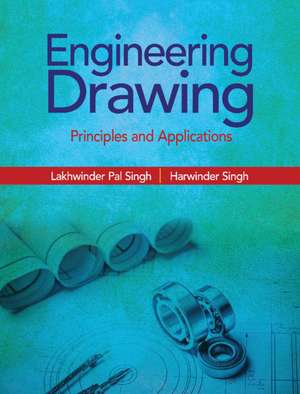Engineering Drawing: Principles and Applications
Autor Lakhwinder Pal Singh, Harwinder Singhen Limba Engleză Paperback – 9 iun 2021
Preț: 593.63 lei
Preț vechi: 667.00 lei
-11% Nou
Puncte Express: 890
Preț estimativ în valută:
113.63€ • 123.47$ • 95.51£
113.63€ • 123.47$ • 95.51£
Carte disponibilă
Livrare economică 31 martie-14 aprilie
Preluare comenzi: 021 569.72.76
Specificații
ISBN-13: 9781108707725
ISBN-10: 1108707726
Pagini: 632
Dimensiuni: 184 x 240 x 28 mm
Greutate: 0.82 kg
Editura: Cambridge University Press
Colecția Cambridge University Press
Locul publicării:Cambridge, United Kingdom
ISBN-10: 1108707726
Pagini: 632
Dimensiuni: 184 x 240 x 28 mm
Greutate: 0.82 kg
Editura: Cambridge University Press
Colecția Cambridge University Press
Locul publicării:Cambridge, United Kingdom
Cuprins
Preface; Chapter 1: Drawing Instruments; 1.1 Introduction; 1.2 List of Draughting Tools; 1.3 Drawing Board; 1.4 Mini-Draughter; 1.5 Small Instrument Box; 1.6 Set Squares; 1.7 Set of Scales; 1.8 Protractor; 1.9 French Curves; 1.10 Drawing Sheets; 1.11 Drawing Pencils; 1.12 Paper Fasteners; 1.13 Sand Paper Pad; 1.14; Eraser; 1.15 Duster; Exercises; Objective Questions; Answers; Chapter 2: Lines, Lettering and Layout of Sheet; 2.1 Introduction; 2.2 Lines; 2.3 Lettering; 2.4 Single Stroke Letters; 2.5 Gothic Letters; 2.6 General Proportions of Letters; 2.7 Drawing Sheet Layout; 2.8 Title Block; Exercises; Objective Questions; Answers; Chapter 3: Principles of Dimensioning; 3.1 Introduction; 3.2 Types of Dimensions; 3.3 Elements of Dimensioning; 3.4 Execution of Dimensions; 3.5 Placing of Dimensions; 3.6 Methods of Dimensioning; 3.7 Principles of Dimensioning; Exercises; Objective Questions; Answers; Chapter 4: Sections and Conventions; 4.1 Introduction; 4.2 Cutting Plane or Sectional Plane; 4.3 Section Lines or Hatching Lines; 4.4 Types of Section; 4.5 Conventions for Various Materials; 4.6 Conventional Breaks; 4.7 Conventional Representation of Common Features; Exercises; Objective Questions; Answers; Chapter 5: Geometrical Constructions; 5.1 Introduction; 5.2 Bisection of a Straight Line; 5.3 Dividing a Line Into Equal Parts; 5.4 Draw a Line Parallel to a Given Straight Line; 5.5 Bisect an Angle; 5.6 Find the Centre of an Arc; 5.7 Constructing an Equilateral Triangle; 5.8 Construct Squares; 5.9 Construct a Regular Polygons; 5.10 To Draw Tangents; 5.11 Inscribed Circles; Exercises; Objective Questions; Answers; Chapter 6: Scales; 6.1 Introduction; 6.2 Representative Fraction or Scale Factor; 6.3 Scales on Drawings; 6.4 Types of Scales; 6.5 Plain Scales; 6.6 Diagonal Scales; Exercises; Objective Questions; Answers; Chapter 7: Orthographic Projections; 7.1 Introduction; 7.2 Methods of Projections; 7.2.1 Perspective Projection; 7.2.2 Parallel Projection; 7.3 Planes of Projection; 7.4 Four Quadrants; 7.5 First-Angle Projection; 7.6 Third-Angle Projection; 7.7 Symbols Used for First-Angle Projection and Third-Angle Projection Methods; Exercises; Objective Questions; Answers; Chapter 8 Projections of Points: 8.1 Introduction; 8.2 Projection of a Point Lying in the First Quadrant; 8.3 Projection of a Point Lying in the Second Quadrant; 8.4 Projection of a Point Lying in the Third Quadrant; 8.5 Projection of Point Lying in the Fourth Quadrant; 8.6 Special Cases; 8.7 A Point is Situated in the Three Planes of Projection; Exercises; Objective Questions; Answers; Chapter 9: Projections of Lines; 9.1 Introduction; 9.2 Position of a Straight Line; 9.3 Line Parallel to Both HP and VP; 9.4 Line Inclined to One Plane and Parallel to the Other; 9.5 Line Perpendicular to One of the Planes; 9.6 Line Contained by One or Both of the Principal Planes; 9.7 Line Inclined to Both HP And VP; 9.8 Line Contained by a Profile Plane (PP) or Line Contained by a Plane, Perpendicular to Both HP and VP; 9.9 Traces of a Line; Exercises; Objective Questions; Answers; Chapter 10: Projections of Planes; 10.1 Introduction; 10.2 Types of Planes; 10.3 Traces of Planes; 10.4 A Secondary Plane in Different Positions with Respect to the Principal Planes; 10.5 Projections of Plane Parallel to One of the Principal Planes; 10.6 Projections of Plane Perpendicular to Both HP and VP; 10.7 Projections of Plane Inclined to One of the Principal Planes and Perpendicular to the other Plane; 10.8 Projections of Plane Inclined to Both the Principal Planes; Exercises; Objective Questions; Answers; Chapter 11: Auxiliary Projections; 11.1 Introduction; 11.2 Types of Auxiliary Planes and Views; 11.3 Projections of Points; 11.4 Projections of Straight Lines; 11.5 Projections of Planes; 11.6 Shortest Distance between two Skew Lines; Additional Problems; Exercises; Objective Questions
Notă biografică
Descriere
This textbook introduces the basic concepts of engineering drawing and graphics, supplemented with numerous solved examples and exercises.
